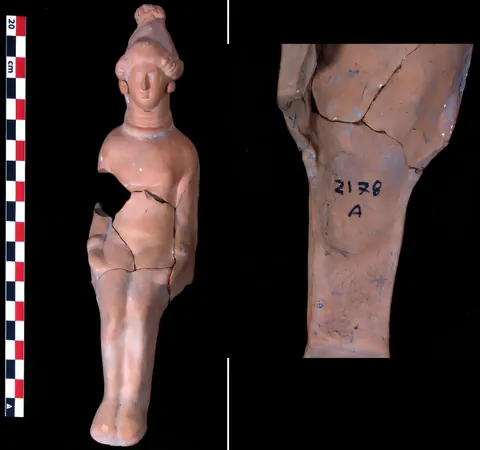
Shocking Findings: Fingerprints on Ancient Terracotta Figurines Reveal Gender and Age of Craftspersons!
2024-11-04
Author: Jia
Groundbreaking Study Uncovers Insights
A groundbreaking study led by Ph.D. student Leonie Hoff from the University of Oxford has uncovered fascinating insights into the craftsmanship behind ancient terracotta figurines. The research, recently published in the Oxford Journal of Archaeology, highlights how the ancient fingerprints found on these figurines can help deduce the age and gender of their makers.
Excavation of Terracotta Figurines
The figurines in question were excavated from the legendary underwater city of Thonis-Heracleion, a major Egyptian port that thrived during the Late and Ptolemaic periods, approximately between the seventh and second centuries BC. This remarkable metropolis, once a bustling trade hub, was rediscovered in the 1990s after fading into obscurity following the establishment of Alexandria. The study in focus marks a prominent step in the field—being the first to utilize Reflectance Transformation Imaging (RTI) technology for analyzing such pieces from this significant era.
Challenging Traditional Perspectives
Historically, little information has been available about the artisans who fashioned these figurines. While it was once assumed that this craft was primarily a male-dominated profession, this study challenges traditional perspectives. Notably, Hoff's findings indicate that men, women, and, surprisingly, children were all involved in the creation process—defying earlier notions of gender exclusivity in this ancient trade.
Innovative Methodology
Utilizing ridge density analysis of the fingerprints—the patterns of skin ridges that can suggest gender—Hoff’s research shows that female fingerprints tend to have a denser arrangement compared to male counterparts. This innovative methodology allows researchers not only to glean the sex of the adult artisans but also to identify the potential age group of the creators. Children’s fingerprints revealed thinner ridges, leading to clarity on their youthful involvement.
Identifying Contributors
The study has so far identified approximately 14 distinct individuals who contributed to the crafting of these figurines. However, there remains a mystery on whether those individuals worked on multiple pieces, mainly due to the fragmentary nature of the artifacts. Although Hoff acknowledges the limitations, she is excited about the potential discoveries awaiting in the unexplored artifacts.
Role of Children in Crafting
What's more, Hoff’s results shed light on the role of children in this craft, revealing that they might have participated in pressing the clay sheets into molds, a task ideally suited to their small hands. Interestingly, child fingerprints were always found alongside those of supervising adults, suggesting a collaborative dynamic in the production process.
Cultural Distinctions in Artisanal Practices
The differences in the supervisory structure between Egyptian and Greek figurine-making practices are particularly revealing. Egyptian mentors appeared to supervise apprentices who were closer in age, while Greek artisans paired younger apprentices with significantly older supervisors. This divergence points to cultural distinctions in skills training and production methodologies.
Future Prospects and Excavations
As Hoff wraps up her initial findings, she remains hopeful for more extensive excavation in Thonis-Heracleion, which would not only enrich our understanding of this ancient craft but also illuminate the everyday lives of those who inhabited Egypt centuries ago.
Anticipation of New Discoveries
So, what more secrets lie beneath the waters of Thonis-Heracleion? The world waits in anticipation as further digs may soon unveil additional stories from this captivating chapter of history!


 Brasil (PT)
Brasil (PT)
 Canada (EN)
Canada (EN)
 Chile (ES)
Chile (ES)
 España (ES)
España (ES)
 France (FR)
France (FR)
 Hong Kong (EN)
Hong Kong (EN)
 Italia (IT)
Italia (IT)
 日本 (JA)
日本 (JA)
 Magyarország (HU)
Magyarország (HU)
 Norge (NO)
Norge (NO)
 Polska (PL)
Polska (PL)
 Schweiz (DE)
Schweiz (DE)
 Singapore (EN)
Singapore (EN)
 Sverige (SV)
Sverige (SV)
 Suomi (FI)
Suomi (FI)
 Türkiye (TR)
Türkiye (TR)